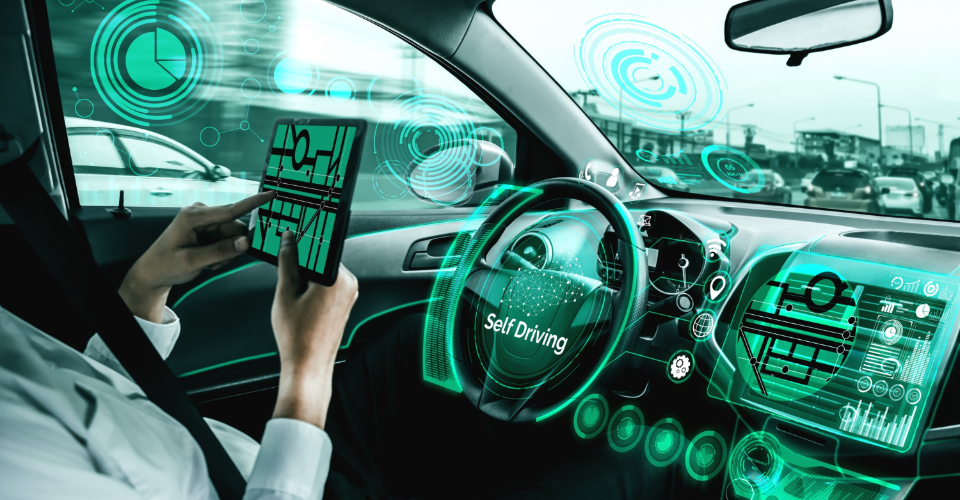The concept of autonomous vehicles (AVs), often known as self-driving or driverless cars, is no longer confined to science fiction. As technology advances rapidly, these vehicles are becoming an increasingly common sight on the streets, ushering in a new era of mobility innovation. We are on the verge of transforming the way we think about transportation—offering a future where cars can navigate and make decisions without human intervention.
In this blog, we’ll take you through the exciting journey of autonomous vehicles, explaining their technology, potential impact on our lives, and the key trends shaping their development.
The Road to Autonomy
Imagine a world where you no longer need to worry about traffic, road signs, or even parking. A world where your car takes care of the driving while you relax, work, or even nap. self-driving cars are paving the way for this future, and it’s not as far away as we think. As a matter of fact, these self-driving cars are already being tested and rolled out on the streets of major cities worldwide.
However, the road to full autonomy is filled with challenges—ranging from technological hurdles to regulatory concerns. In this post, we’ll dive deep into the technology, benefits, challenges, and future of driverless technology.
Autonomous Vehicles:
Autonomous vehicles (AVs) are revolutionizing transportation technology, bringing futuristic driverless technology to our roadways. These robotic vehicles rely on an advanced combination of sensors, cameras, radar, and artificial intelligence (AI) to navigate without human intervention.
Here’s how these technologies work together to ensure smooth and safe travel:
- Sensors and Cameras: These devices collect real-time data about the environment, detecting objects like pedestrians, traffic signals, and road signs.
- Radar: Radar helps AVs track the distance and speed of objects in close proximity, even in low-visibility conditions such as rain or fog.
- Artificial Intelligence (AI): AI processes the vast amount of data gathered by these devices. Using machine learning and neural networks, the vehicle’s system can make instant driving decisions—much like a human driver, but faster and without the risk of distraction.
- Decision-Making Algorithms: These algorithms allow the vehicle to prioritize safety, adjusting speed, direction, and braking in response to real-time traffic conditions.
Statistical Insight: According to a 2023 report from the National Highway Traffic Safety Administration (NHTSA), self-driving cars could prevent over 90% of road traffic accidents, contributing to safer roadways globally. With mobility innovation driving these advancements, the market for autonomous vehicles is expected to grow to USD 2.2 trillion by 2030.
Challenges on the Road to Full Autonomy
While autonomous vehicles (AVs) present transformative potential, several hurdles remain on the path to full autonomy. Overcoming these challenges is crucial for the widespread integration of driverless technology into daily life.
- Technology Limitations:
Achieving the precision of human drivers is one of the biggest obstacles for robotic vehicles. AVs must undergo extensive testing, requiring millions of miles of real-world driving to ensure their safety and reliability. The current technology still struggles with complex environments such as adverse weather conditions and unpredictable human behaviors.
- Statistical Insight: AVs need to travel approximately 291 million miles to reach a 95% safety equivalency to human drivers, according to research from the University of Michigan.
- Statistical Insight: AVs need to travel approximately 291 million miles to reach a 95% safety equivalency to human drivers, according to research from the University of Michigan.
- Regulations:
Governments around the world are still trying to define clear and consistent regulations for autonomous vehicles. Each country has its own set of rules, and international collaboration is essential to establish a unified framework. Legal questions surrounding liability and insurance also need to be addressed.
- Statistical Insight: As of 2023, only 14 U.S. states have comprehensive laws for AV testing, while Europe is progressing with separate national frameworks.
- Statistical Insight: As of 2023, only 14 U.S. states have comprehensive laws for AV testing, while Europe is progressing with separate national frameworks.
- Infrastructure:
For self-driving cars to function effectively, robust infrastructure is needed. This includes well-marked lanes, accurate GPS systems, and the development of 5G networks to support real-time data processing. Without these improvements, robotic vehicles may face limitations in urban and rural environments.
- Statistical Insight: The International Transport Forum estimates that 50% of cities worldwide lack the infrastructure necessary to fully support driverless technology.
- Statistical Insight: The International Transport Forum estimates that 50% of cities worldwide lack the infrastructure necessary to fully support driverless technology.
- Public Trust:
Despite the promise of mobility innovation, public skepticism remains a significant barrier. Many people are uncomfortable with the idea of a robotic vehicle taking control of the driving. Building consumer trust through transparent testing, safety standards, and education is essential for ensuring the widespread adoption of transportation technology.
- Statistical Insight: A survey by AAA found that 71% of U.S. drivers would feel afraid to ride in a fully autonomous vehicle, highlighting the need for improved public confidence.
- Statistical Insight: A survey by AAA found that 71% of U.S. drivers would feel afraid to ride in a fully autonomous vehicle, highlighting the need for improved public confidence.
Autonomous Vehicles in Different Segments
There are multiple vehicle segments where robotic vehicles can be implemented, such as:
- Passenger Vehicles: These include private cars and shared vehicles (robo-taxis). By 2040, it’s predicted that over 33 million autonomous vehicles will be on the roads.
- Autonomous Trucks: Freight transportation is another area where AV technology is being explored, particularly through truck platooning—a process where trucks follow each other autonomously on highways.
- Robo-taxis: Ride-hailing services like Uber and Lyft are already experimenting with self-driving cars to replace traditional drivers.
The Global Autonomous Vehicle Market
The self-driving cars market is experiencing rapid growth. In 2021, the global market for Level 1 and Level 2 autonomous vehicles was valued at approximately USD 106 billion. By 2030, this market is projected to reach over USD 2.2 trillion, growing at a compound annual growth rate (CAGR) of 35.6%.
Asia-Pacific is expected to be the largest market, followed by Europe and North America. Key drivers of this growth include increased demand for safer, more efficient transportation, as well as rising disposable income and stricter safety regulations worldwide.
Autonomous Vehicles in the Middle East: A Pioneering Region
The UAE has made significant strides in testing and adopting autonomous vehicles. By 2030, Dubai aims to have 25% of all trips made via self-driving vehicles. The Roads and Transport Authority (RTA) of Dubai has already signed agreements with companies like Cruise to operate autonomous taxis, marking a significant step in the region’s goal to become a leader in mobility innovation.
7 Key Insights on Autonomous Vehicles
Autonomous vehicles (AVs) are transforming the future of transportation with driverless technology, promising to revolutionize the way we travel. These innovations are reshaping mobility, offering safer, more efficient travel solutions. As we explore this technological evolution, it’s clear that unmanned vehicles are paving the way for the next generation of transportation technology. Here are 7 key insights into the world of robotic vehicles and their potential to change the future of mobility innovation.
1. The Evolution of Autonomous Vehicles
Autonomous vehicles have come a long way from their early prototypes. Initially, AVs were thought to be far off, but technological advancements have made them a reality in many parts of the world.
- Timeline of Development:
- 2000s: Early research began with projects like Google’s self-driving car.2010s: Companies such as Tesla, Waymo, and Uber began testing autonomous systems.2020s: Increased public testing and commercial pilot programs are happening in cities like San Francisco and Dubai.
Statistical Insight: According to McKinsey & Company, the global market for driverless vehicles is expected to grow from USD 106 billion in 2021 to over USD 2.2 trillion by 2030, driven by a compound annual growth rate (CAGR) of 35.6%. This massive growth is attributed to the increasing demand for driverless technology and the benefits it offers in terms of safety, efficiency, and convenience.
2. Levels of Autonomy in Vehicles
The technology behind autonomous vehicles is categorized into six levels of automation, as defined by the Society of Automotive Engineers (SAE). These levels range from complete manual control (Level 0) to fully robotic vehicles that require no human input (Level 5).
- Level 0: No automation – the driver controls all aspects of the vehicle.
- Level 1: Driver assistance – features like cruise control.
- Level 2: Partial automation – systems like lane-keeping assist and adaptive cruise control, though the driver must remain engaged.
- Level 3: Conditional automation – the vehicle can handle all driving tasks in certain conditions, but the driver must take over if necessary.
- Level 4: High automation – the vehicle can operate autonomously in most environments but may require human intervention in complex scenarios.
- Level 5: Full automation – the vehicle is fully autonomous, requiring no human driver.
Statistical Insight: As of 2023, most vehicles on the road are at Level 2 automation. However, prototypes for Level 4 and Level 5 automation are being tested in limited regions, with Level 5 expected to be commercially available by the late 2020s or early 2030s.
3. Technologies Behind Autonomous Vehicles
Driverless technology relies on a combination of advanced sensors, algorithms, and computing power. These technologies enable robotic vehicles to make real-time decisions based on their surroundings.
- Key Components:
- Sensors: LIDAR, radar, and cameras provide a 360-degree view of the environment.
- Artificial Intelligence: AI processes sensor data, identifies objects, and makes driving decisions.
- Machine Learning: AVs improve their driving performance by learning from vast amounts of data, including road conditions, traffic patterns, and pedestrian behaviors.
Statistical Insight: In a survey by McKinsey & Company, 60% of executives identified the development of AI algorithms and sensors as the primary technology needed to enhance automated vehicles. Over the next decade, AI and sensor-based systems are expected to account for up to 30% of the overall cost of robotic vehicles.
4. Impact on Safety and Efficiency
One of the most significant promises of autonomous vehicles is their potential to enhance road safety and reduce accidents caused by human error.
- Reduction in Accidents: Around 94% of road accidents are attributed to human error, including distractions, impairment, and poor judgment. AVs can reduce these risks significantly by adhering to strict protocols for speed limits, road signs, and real-time environmental awareness.
- Efficiency in Traffic: Driverless technology can also help reduce traffic congestion and improve fuel efficiency. By optimizing route planning and driving behavior, AVs can decrease fuel consumption and minimize delays.
Statistical Insight: According to a report from the National Highway Traffic Safety Administration (NHTSA), autonomous vehicles have the potential to reduce traffic accidents by up to 90%, saving thousands of lives annually. The economic benefits from reduced crashes could reach over USD 200 billion per year.
5. Economic Impact and Job Displacement
The rise of autonomous vehicles will create significant economic changes, including job displacement and the emergence of new industries.
- Job Displacement: With robotic vehicles replacing human drivers, industries like transportation, logistics, and delivery will see significant job losses. Truck drivers, taxi drivers, and delivery personnel may be impacted most.
- New Economic Opportunities: On the flip side, the development and implementation of autonomous vehicles will generate new jobs in fields like AI development, vehicle maintenance, and data analysis. Additionally, new business models, such as mobility-as-a-service (MaaS), will emerge.
Statistical Insight: A report by the Brookings Institution estimates that nearly 25% of U.S. jobs could be threatened by automation over the next few decades, including jobs related to driverless technology. However, it also predicts that the autonomous vehicle market could add USD 800 billion in annual revenue by 2035.
6. Environmental Benefits of Autonomous Vehicles
Autonomous vehicles are not only improving safety and efficiency—they also have the potential to help reduce carbon emissions and contribute to sustainability goals.
- Reduced Emissions: Autonomous vehicles, particularly electric robotic vehicles, can significantly lower carbon emissions by optimizing driving behavior, reducing fuel consumption, and transitioning away from fossil fuel reliance.
- Shared Mobility: Mobility innovation through shared transportation services like robo-taxis and autonomous shuttles can further reduce the number of vehicles on the road, decreasing traffic congestion and lowering emissions.
Statistical Insight: According to a study by the International Council on Clean Transportation (ICCT), autonomous electric vehicles could reduce greenhouse gas emissions by up to 80% by 2050, compared to traditional gas-powered vehicles. The widespread adoption of AVs could reduce the total number of vehicles in circulation, further contributing to environmental sustainability.
7. Regulatory and Infrastructure Challenges
Despite the rapid advancements in autonomous vehicles, there are significant regulatory and infrastructure challenges that need to be addressed before they can achieve widespread adoption.
- Regulation: Governments around the world are struggling to create frameworks to safely test and deploy autonomous vehicles. While countries like the U.S. and Germany have made significant progress, many regions still lack clear policies.
- Infrastructure: For driverless technology to work at its full potential, it requires well-developed infrastructure, including smart roads, high-speed internet, and real-time data sharing. Without these elements, the effectiveness of robotic vehicles could be limited.
Statistical Insight: According to a survey conducted by the European Commission, 65% of EU citizens expressed concern about the lack of clear regulations for AVs. In the U.S., the National Governors Association reports that only 14 states have enacted comprehensive laws regarding autonomous vehicle testing and deployment.
The future of autonomous vehicles is exciting, with driverless technology set to revolutionize the transportation sector. From enhancing safety to reducing emissions and transforming economic landscapes, AVs offer numerous benefits. However, challenges remain, particularly with regulatory frameworks, infrastructure, and societal adaptation.
The growth of robotic vehicles and mobility innovation will continue to shape the world of transportation in the coming years. As advancements progress, we can expect autonomous vehicles to become more integrated into our daily lives, offering safer, more efficient, and environmentally friendly alternatives to traditional transportation systems.
Final Insight: With the global market for AVs set to reach over USD 2.2 trillion by 2030, we stand on the cusp of a new era in transportation technology—one that promises to redefine how we travel, work, and interact with our world.
Key Takeaways
- Autonomous vehicles are set to revolutionize transportation, offering safer and more efficient travel.
- While most cars today are at Level 2 automation, advancements in driverless technology are moving us closer to fully autonomous vehicles.
- The autonomous vehicle market is growing rapidly, with projections of reaching over USD 2 trillion by 2030.
- Challenges such as technology limitations, regulatory frameworks, and public trust need to be addressed before full adoption.
At a Glance
- Focus Keyword: Autonomous Vehicles
- Market Growth: From USD 106 billion in 2021 to over USD 2.2 trillion by 2030.
- Regional Pioneers: The UAE is leading the way in autonomous vehicle testing and adoption.
- Challenges: Technology, regulations, and public trust are key barriers to widespread adoption.
Frequently Asked Questions (FAQs)
Q1: What are autonomous vehicles?
A1: Autonomous vehicles are cars that can drive themselves using sensors, AI, and machine learning. They don’t require human intervention for most driving tasks.
Q2: When will fully autonomous cars be available?
A2: While Level 5 autonomous vehicles are still under development, we can expect more widespread availability of driverless cars in the next decade.
Q3: Are autonomous vehicles safe?
A3: While AVs are safer than human-driven cars in many situations, there are still technological and regulatory challenges to overcome before they can be fully trusted.
Conclusion: The Road Ahead
The future of autonomous vehicles is bright, with the potential to transform transportation as we know it. From improving safety on the roads to reducing traffic congestion, AVs will undoubtedly make our lives more convenient and efficient. However, we must navigate challenges related to technology, regulation, and public perception before we can see widespread adoption.
We are excited to be part of this journey and look forward to a future where driverless technology becomes the norm. The road ahead may be long, but the destination is certainly worth the drive.



















Leave a Reply